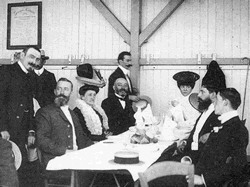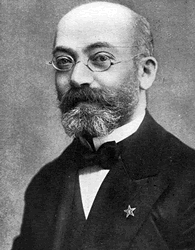Ludvic Lazarus Zamenhof
Ludvic Lazarus ZaImage:1908-kl-t-zamenhof.jpgmenhof (pronounced /ˈzÉ‘Ë?mɨnhÉ’f/ in English; born Eliezer Samenhof, December 15, 1859 – April 14, 1917) was an ophthalmologist, philologist, and the inventor of Esperanto, a constructed language designed for international communication.
As of 1975, Esperanto was taught in 600 schools to 20,000 students per year; and there were about 100 journals and 7500 books written in Esperanto, including translations from 65 languages. In addition, it had by that time been used in more than 700 international conferences. As of 2000, per Cambridge Encyclopedia, it had somewhere between 1 and 15 million speakers, according to sources referenced
Zamenhof was born on December 15, 1859 in the town of Białystok (now in Poland, then under Russian rule) to parents of Lithuanian Jewish descent. He considered his native language to be his father's Russian, though he also spoke his mother's Yiddish; as he grew older, he spoke more Polish, and that became the native language of his children.[1] His father was a German teacher, and he also spoke that fluently. It is likely he also spoke Belarusian, which appears to have had a strong influence on Esperanto phonology, but which was not considered distinct from Russian at the time. Later he learned French, Latin, Greek, Hebrew and English, and had an interest in Italian, Spanish and Lithuanian.
In addition to the Yiddish-speaking Jewish majority, the population of Białystok was made up of three other ethnic groups: Poles, Germans, and Belarusians. Zamenhof was saddened and frustrated by the many quarrels between these groups. He supposed that the main reason for the hate and prejudice lay in mutual misunderstanding, caused by the lack of one common language that would play the role of a neutral communication tool between people of different ethnic and linguistic backgrounds.
As a student at secondary school in Warsaw, Zamenhof made attempts to create some kind of international language with a grammar that was very rich, but also very complex. When he later studied English, he decided that the international language must have a simpler grammar. Apart from his parents' native languages Russian and Yiddish and his adopted language Polish, his lingustics attempts were also aided by his mastering of German, a good passive understanding of Latin, Hebrew and French, and a rather poor knowledge of Greek, English and Italian.[2]
By 1878, his project Lingwe uniwersala was almost finished. However Zamenhof was too young then to publish his work. Soon after graduation from school he began to study medicine, first in Moscow, and later in Warsaw. In 1885, Zamenhof graduated from a university and began his practice as a doctor in Veisiejai and since 1886 as an ophthalmologist in Plock and Vienna. While healing people there he continued to work on his project of the international language.
In 1879, Zamenhof wrote the first grammar of the Yiddish language, which he published in part years later in the Yiddish magazine "Lebn un visnshaft" (Life and Science, Vilna, 1909; see Esperanto translation as «Pri jida gramatiko kaj reformo en la jida» in «Hebreo el la geto: de cionismo al hilelismo», Eldonejo Ludovikito, vol. 5, 1976). Complete original Russian text of this manuscript with parallel Esperanto translation was only published in 1982 (translated by Adolf Holzhaus in «L. Zamennhof, provo de gramatiko de novjuda lingvo», Helsinki, p. 9-36). In this work, not only does he provide a review of the Yiddish grammar, but also proposes its transition to the Latin script and other orthographic innovations. In the same period, Zamenhof wrote some other works in Yiddish, including perhaps the first survey of the Yiddish poetics (see p. 50 in the above-cited book).
For two years he tried to raise funds to publish a booklet describing the language until he received the financial help from his future wife's father. In 1887, the book titled as "Lingvo internacia. AntaÅparolo kaj plena lernolibro" (International Language. Foreword And Complete Textbook) was published under the pseudonym "Doktoro Esperanto" (Doctor Hopeful), from which the name of the language derives. For Zamenhof this language wasn't merely a communication tool, but a means of spreading his ideas on the peaceful coexistence of different peoples and cultures. Among the many works he translated into Esperanto is the Hebrew Bible or Old Testament.
Zamenhof and his wife Klara raised three children: a son, Adam, and two daughters, Sofia and Lidia. All three perished in the Holocaust.
Lidia Zamenhof in particular took a keen interest in Esperanto, and as an adult became a teacher of the language, traveling through Europe and to America to teach classes in it. Through her friendship with Martha Root, Lidia accepted Bahá'u'lláh and became a member of the Bahá'à faith. As one of its social principles, the Bahá'à faith teaches that an auxiliary world language should be selected by the representatives of all the world's nations.
In 1910, Zamenhof was nominated for the Nobel Peace Prize, by four British Members of Parliament (including James O'Grady, Philip Snowden) and Professor Stanley Lane Poole.[3] The Prize was awarded to the International Peace Bureau.
Zamenhof died in Warsaw on April 14, 1917, and is buried in the Okopowa Street Jewish Cemetery in that city.

Families Zamenhof and Michaux at the first Esperanto Congress, Boulogne 1905
Homaranismo
Main article: Homaranismo
Outside his linguistic work, Zamenhof published a religious philosophy he called Homaranismo (loosely translated as humanitarianism), based on the principles and teachings of Hillel the Elder.
